Garmin A4ATGB01 Low Power Transmitter 2402-2480 MHz User Manual 1
Garmin International Inc Low Power Transmitter 2402-2480 MHz 1
Garmin >
Contents
- 1. User Manual 1
- 2. User Manual 2
User Manual 1
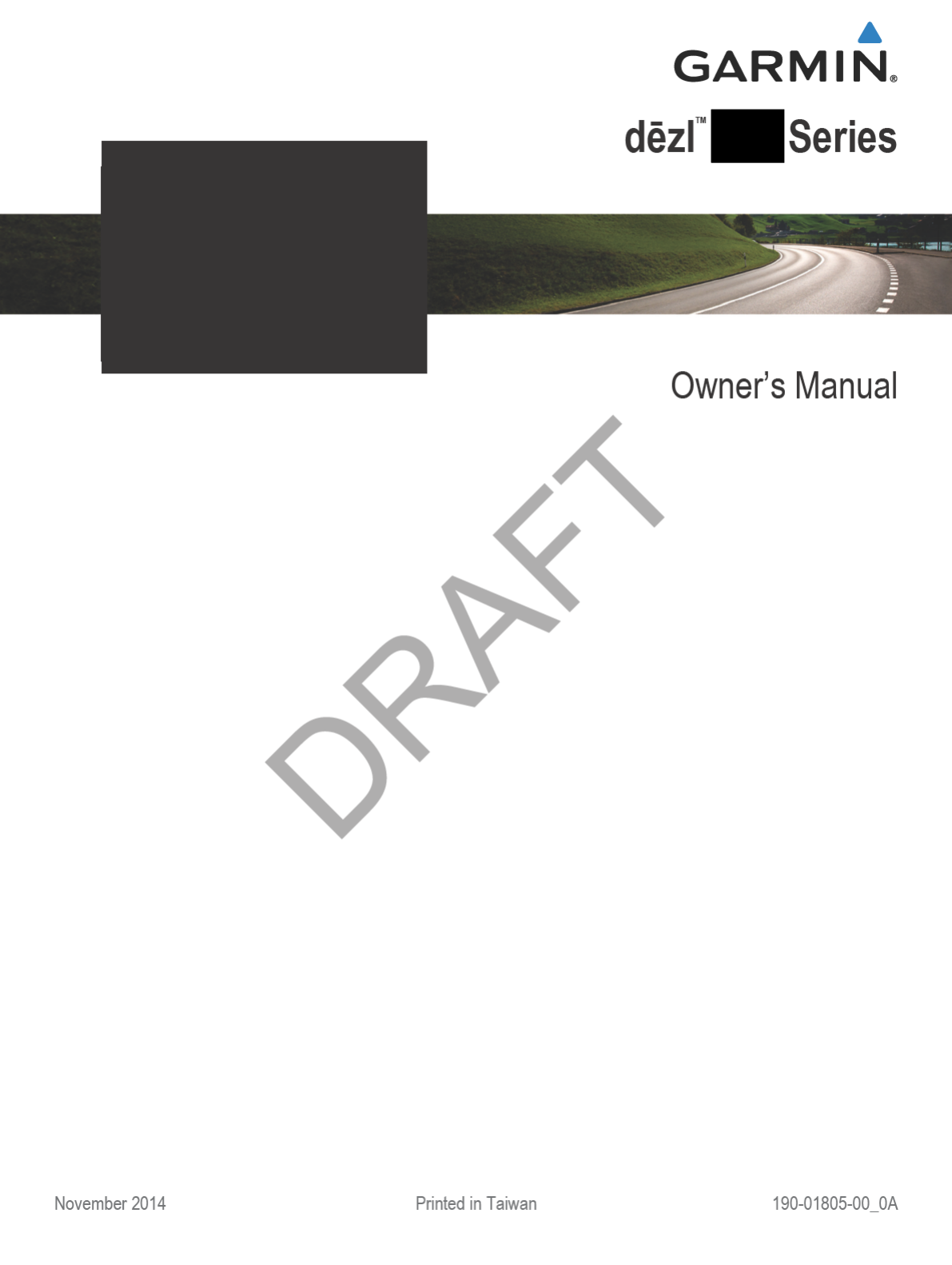
All rights reserved. Under the copyright laws, this manual may not be copied, in whole or in part, without the written consent of Garmin. Garmin reserves the
right to change or improve its products and to make changes in the content of this manual without obligation to notify any person or organization of such
changes or improvements. Go to www.garmin.com for current updates and supplemental information concerning the use of this product.
Garmin® and the Garmin logo are trademarks of Garmin Ltd. or its subsidiaries, registered in the USA and other countries. These trademarks may not be used
without the express permission of Garmin.
BaseCamp™, dēzl™, Garmin Express™, HomePort™, MapSource®, myGarmin™, ecoRoute™, myTrends™, trafficTrends™, nüMaps Guarantee™, and nüMaps
Lifetime™ are trademarks of Garmin Ltd. or its subsidiaries. These trademarks may not be used without the express permission of Garmin.
The Bluetooth® word mark and logos are owned by the Bluetooth SIG, Inc., and any use of such word mark or logo by Garmin is under license. Foursquare®
is a trademark of Foursquare Labs, Inc. in the U.S. and in other countries. microSD™ and the microSDHC logo are trademarks of SD-3C, LLC. Windows®,
Windows Vista®, and Windows XP® are registered trademarks of Microsoft Corporation in the United States and other countries. Mac® is a trademark of
Apple Inc. HD Radio™ and the HD logo are trademarks of iBiquity Digital Corporation. HD Radio Technology manufactured under license from iBiquity Digital
Corporation. U.S. and foreign patents.
DRAFT


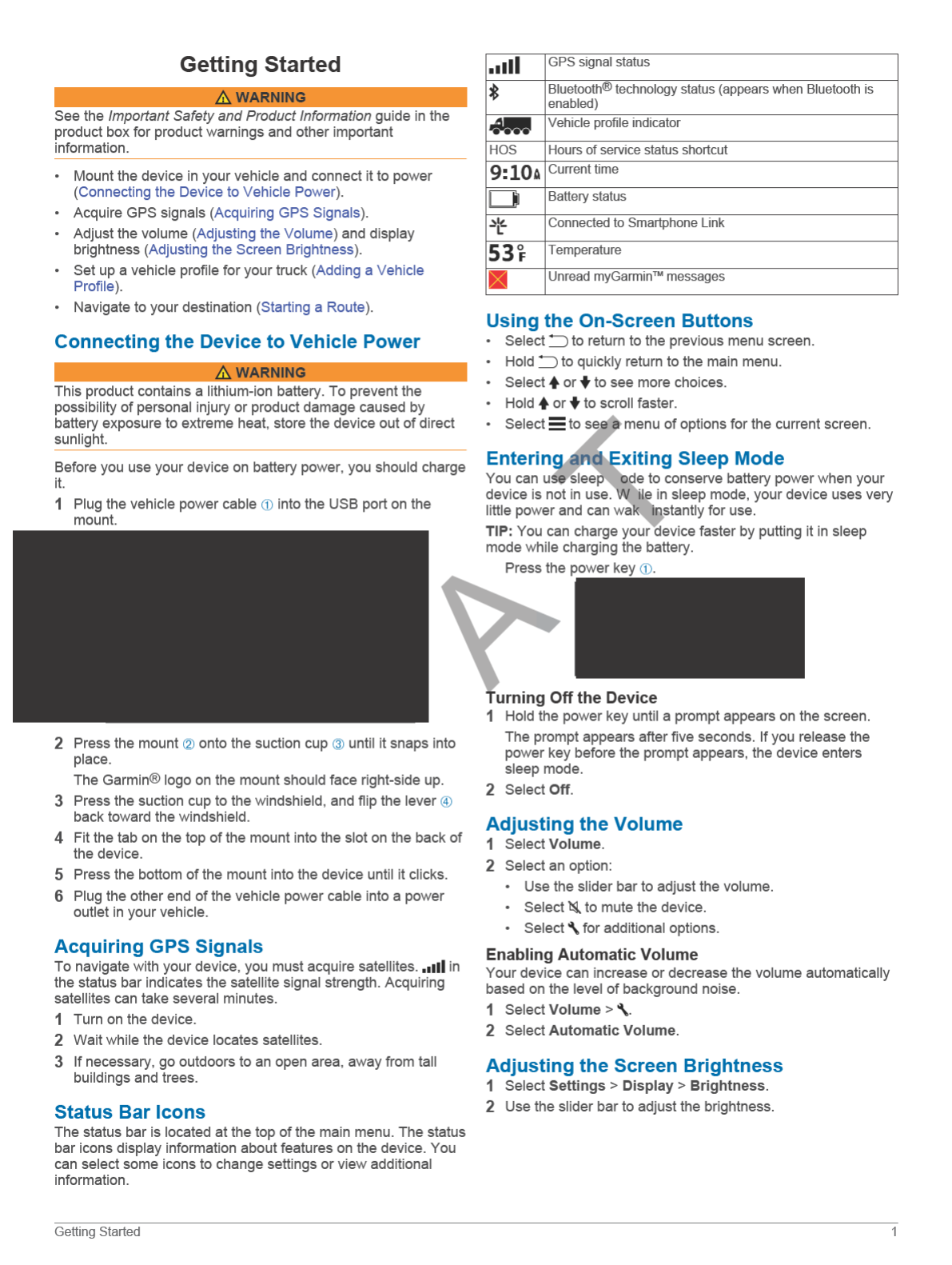

Navigating to Your Destination
Routes
A route is a path from your current location to a destination. A
route may include multiple locations, or stops, on the way to the
destination (Adding a Location to Your Route). The device
calculates the route to your destination based on the
preferences you select in the navigation settings, such as the
route calculation mode (Changing the Route Calculation Mode)
and avoidances (Avoiding Delays, Fees, and Areas). The device
can also avoid ro ds that are not appropriate for the active
vehicle profile ( ehicle Profiles).
Starting a Rou e
1Sel ct Where To?.
2elect Enter Search, enter a search term, and select
Finding a Location Using the Search Bar).
TIP ou can also search for locations using categories,
searc tools, or other methods (Finding Locations).
3Select a cation.
4Select Go!.
The device calculates a route to the location and guides you
using voice prompts and information on the map (Your Route on
the Map).
If you need to stop at additional locations, you can add the
locations to your route (Adding a Location to Your Route). You
can also shape the route to adjust its course (Shaping Your
Route).
Going Home
Select Where To? > Go Home.
Editing Your Home Location Information
1Select Where To? > Saved > Home.
2Select .
3Select > Edit.
4Enter your changes.
5Select Done.
Your Route on the Map
NOTICE
The speed limit feature is for information only and does not
replace your responsibility to abide by all posted speed limit
signs and to use safe driving judgment at all times. Garmin will
not be responsible for any traffic fines or citations you receive for
failing to follow all applicable traffic laws and signs.
As you travel, the device guides you to your destination using
voice prompts and information on the map.
2 Vehicle Profiles
FT

Instructions for your next turn or exit, or other action appear
across the top of the map. The symbol À indicates the type of
action and the lane or lanes in which you should be traveling, if
available. The device also displays the distance to the next
action Á and the name of the street or exit associated with that
action Â.
A colored line à highlights the course of your route on the map
Arrows on the map Ä indicate upcoming turns. When you
approach your destination, a checkered flag indicates the
location of your destination.
Your vehicle speed Å, the road on which you are traveling Æ,
and your estimated arrival time Ç appear at the bottom of the
map. You can customize the arrival time data field to display
other information (Changing the Map Data Field).
A data field displaying the speed limit may appear as you trave
on major roadways. This feature is not available in all areas.
Active Lane Guidance
As you approach a turn while navigating a route, a detailed
simulation of the road appears beside the map, if available. A
colored line indicates the proper lane for the turn.
Viewing a List of Turns
While navigating a route, you can view all of the turns and
maneuvers for your entire route and the distance between turn
1While navigating a route, select the text bar on the top of the
map.
2Select a turn.
The details for the turn appear. If available n image the
junction appears for junctions on major roadw ys.
Viewing the Entire Route on the M p
1While navigating a route, select anywhere on he ma
2Select .
Adding a Location to Your Route
Before you can add a location to your route y must be
navigating a route (Starting a Route).
You can navigate to additional locations on the way to your
destination. For example, you can add a fuel station as the next
stop in your route. You can also add a location to the end of
your route.
TIP: To create complex routes with multiple locations or
scheduled stops, you can use the trip planner to plan, edit, and
save your route (Planning a Trip).
1From the map, select > Where To?.
2Search for a location (Finding Locations).
3Select a location.
4Select Go!.
5Select an option:
• To add the location as the next stop in your route, select
Add as Next Stop.
• To add the location to the end of your route, select Add as
Last Stop.
• To add the location and adjust the order of locations in
your route, select Add to Active Route.
Your device re-calculates the route to include the added location
and guides you to the locations in order.
Taking a Detour
Befor you can take a detour, you must be navigating a route
an you must add the change route tool to the map tools menu
(En bling Map Tools).
You ca ake a detour for a specified distance along your route
or detour round specific roads. This is useful if you encounter
onstruction zones, closed roads, or poor road conditions.
1ro the map, select > Change Route.
2Select an option:
• To detour your route for a specific distance, select Detour
by Distance.
• To detour around a specific road on the route, select
Detour by Road.
Stopping the Route
From the map, select > Stop.
Changing the Route Calculation Mode
1Select Settings > Navigation > Calculation Mode.
2Select an option:
• Select Faster Time to calculate routes that are faster to
drive but can be longer in distance.
• Select Off Road to calculate point-to-point routes (without
roads).
• Select Less Fuel to calculate routes that are more fuel-
efficient.
• Select Shorter Distance to calculate routes that are
shorter in distance but can take more time to drive.
Starting a Route by Using the Map
You can start route by selecting a location from the map.
1Select View Map.
2Drag and zoom the map to display the area to search.
3If necessary, select to filter the displayed points of interest
by category.
Location markers ( or a blue dot) appear on the map.
4Select an option:
• Select a location marker.
Navigating to Your Destination 3
DRAF
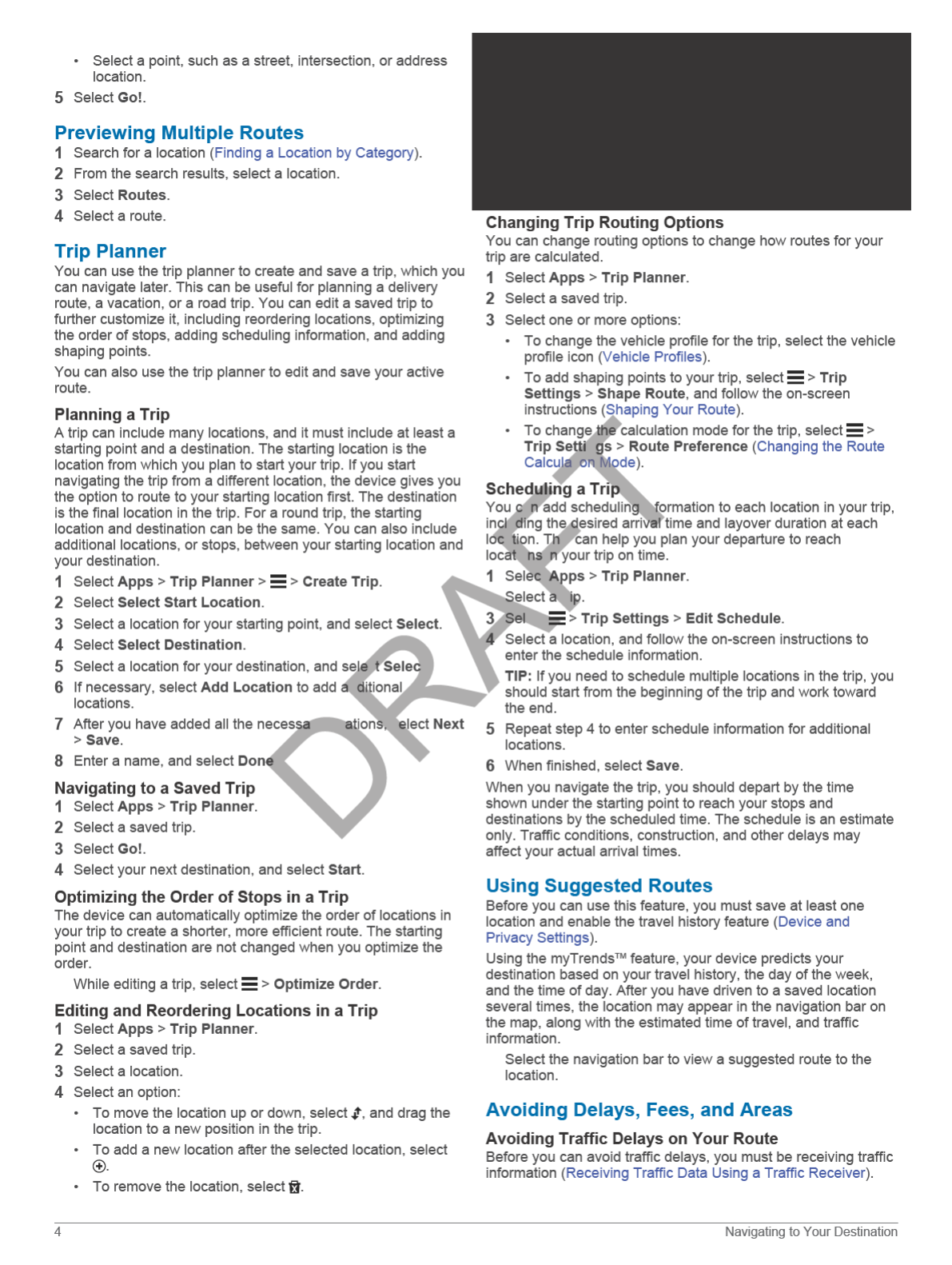
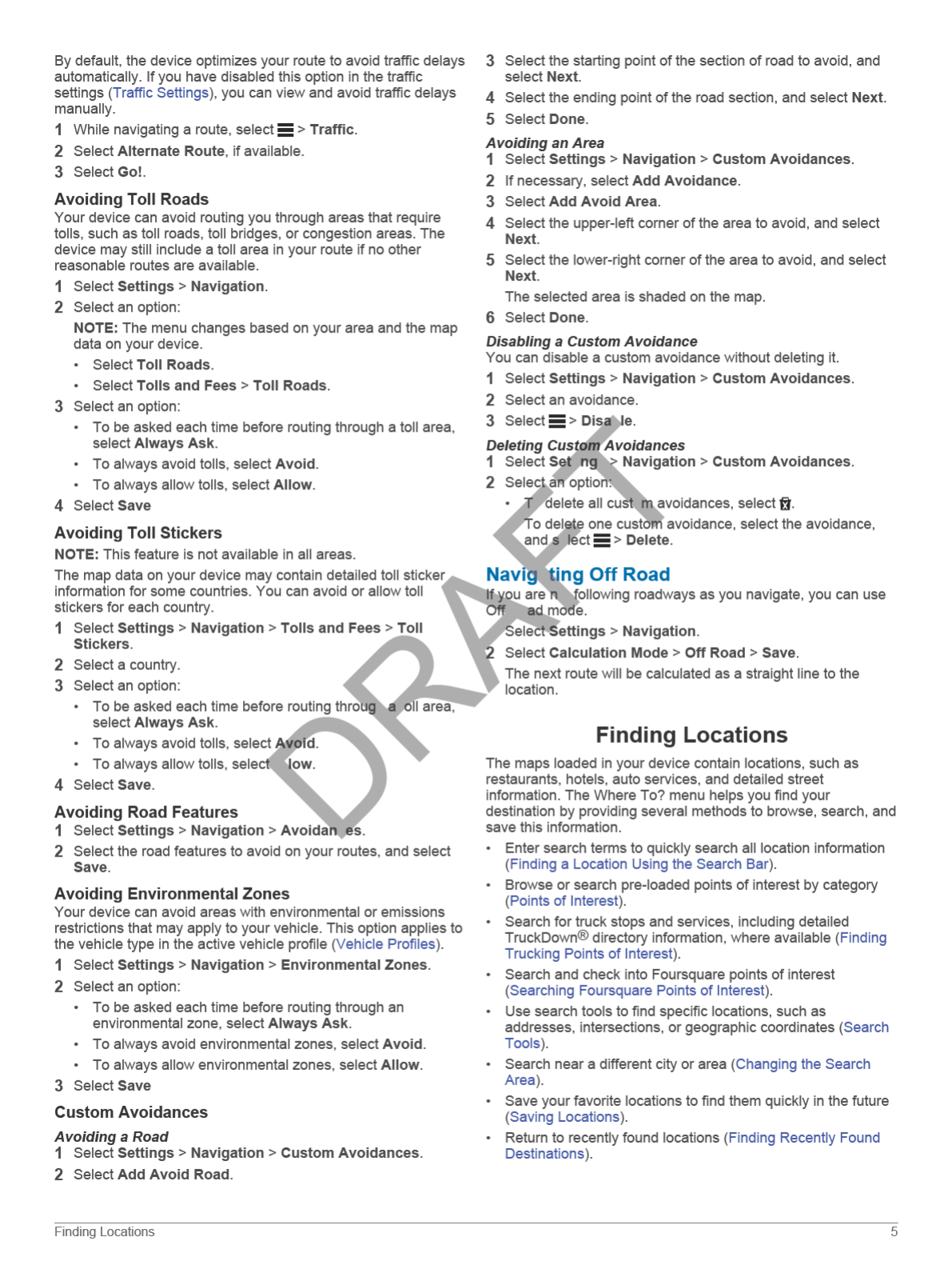
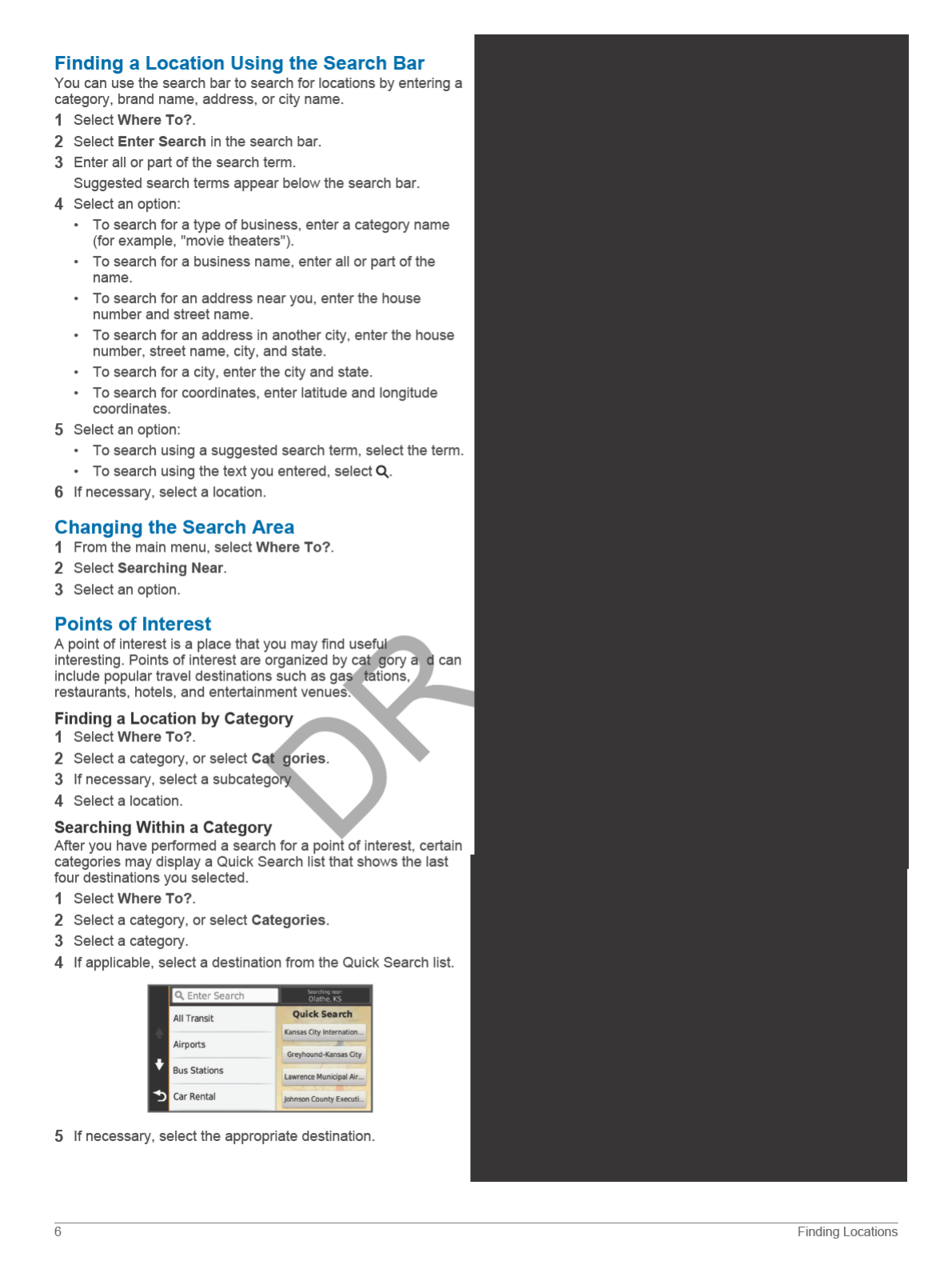

Custom Points of Interest
Custom POIs are customized points on the map. They can
contain alerts that let you know if you are near a designated
point or if you are traveling faster than a specified speed.
Installing POI Loader
You can create or download custom POI lists on your compute
and install them on your device using POI Loader software.
1Go to www.garmin.com/poiloader.
2Follow the on-screen instructions.
Finding Custom POIs
Before you can find custom POIs, you must load st m POIs
on your device using the POI Loader soft e (Insta ng POI
Loader).
1Select Where To? > Categorie
2Scroll to the Other Categories sec n, and sele a category.
Search Tools
Search tools allow you to search for specific types of locations
by responding to on-screen prompts.
Finding an Address
NOTE: The order of the steps may change depending on the
map data loaded on your device.
1Select Where To?.
2If necessary, select Searching Near to change the search
area (Changing the Search Area).
3Select Address.
4Follow the on-screen instructions to enter address
information.
5Select the address.
Finding an Intersection
You can search for an intersection or junction between two
streets, highways, or other roads.
1Select Where To? > Categories > Intersections.
2Follow the on-screen instructions to enter street information.
3Select the intersection.
Finding a City
1Select Where To? > Categories > Cities.
2Select an option:
• Select a city from the list of nearby cities.
• To search near another location, select Searching Near
(Changing the Search Area).
• To search for a city by name, select Enter Search, enter a
city name, and select .
Finding a Location Using Coordinates
You can find a location using latitude and longitude coordinates.
This can be helpful when geocaching.
1Select Where To? > Categories > Coordinates.
2If necessary, select , and change the coordinate format or
datum.
3Enter the latitude and longitude coordinates.
4Select View on Map.
Finding Recently Found Destinations
Your device stores the last 50 destinations you have found.
1Select Where To? > Recent.
2Select a loc on.
Clearing the List f Recently Found Locations
Sele t Where To? Recent > > Clear > Yes.
Fi ding Your Last Parking Spot
Whe yo disconnect the device from vehicle power while the
device on, your current location is saved as a parking spot.
Select Apps > Last Spot.
Viewing Current Location Information
You can use the Where Am I? page to view information about
your current location. This feature is helpful if you need to tell
mergency personnel your location.
From the map, select the vehicle.
Finding Emergency Services and Fuel
You can use the Where Am I? page to find the nearest
hospitals, police stations, and fuel stations.
1From the map, select the vehicle.
2Select Hospitals, Police Stations, or Fuel.
NOTE: When a truck vehicle profile is active, an option for
truck stops appears instead of fuel.
A list of locations for the selected service appears, with the
nearest locations at the top.
3Select a location.
4Select an option:
• To navigate to the location, select Go!
• To view the phone number and other location details,
select .
Getting Directions to Your Current Location
If you need to tell another person how to get to your current
location, your device can give you a list of directions.
1From the map, select the vehicle.
2Select > Directions to Me.
3Select a starting location.
4Select Select.
Adding a Shortcut
You can add shortcuts to the Where To? menu. A shortcut can
point to a location, a category, or a search tool.
Finding Locations 7
DRAFT

The Where To? menu can contain up to 36 shortcut icons.
1Select Where To? > Add Shortcut.
2Select an item.
Removing a Shortcut
1Select Where To? > > Remove Shortcut(s).
2Select the shortcut to remove.
3Select the shortcut again to confirm.
4Select Save.
Saving Locations
Saving a Location
1Search for a location (Finding a Location by Category).
2From the search results, select a location.
3Select .
4Select Save.
5If necessary, enter a name, and select Done.
Saving Your Current Location
1From the map, select the vehicle icon.
2Select Save.
3Enter a name, and select Done.
4Select OK.
Saving a Home Location
You can set your home location for the location you return to
most often.
1Select Where To? > > Set Home Location.
2Select Enter My Address, Use Current Location, or
Recently Found.
The location is saved as "Home" in the Saved menu.
Going Home
Select Where To? > Go Home.
Editing Your Home Location Information
1Select Where To? > Saved > Home.
2Select .
3Select > Edit.
4Enter your changes.
5Select Done.
Editing a Saved Location
1Select Where To? > Saved.
2If necessary, select a category.
3Select a location.
4Select .
5Select > Edit.
6Select an option:
• Select Name.
• Select Phone Number.
• Select Categories to assign categories to the saved
location.
• Select Change Map Symbol to change the symbol used
to mark the saved location on a map.
7Edit the information.
8Select Done.
Assigning Categories to a Saved Location
You can add custom categories to organize your saved
locations.
NOTE: Categories appear in the saved locations menu after you
have saved at least 12 locations.
1Select Where To? > Saved.
2Select a location.
3Select .
4Select > Edit > Categories.
5Enter one or more category names, separated by commas.
6If necessary, select a suggested category.
7Select Done.
Deleting a Saved Location
NOTE: Deleted locations cannot be recovered.
1Select Where To? > Saved.
2Select > Delete Saved Places.
3Select the box next to the saved locations to delete, and
select Delete.
Using the Map
You can use the map to navigate a route (Your Route on the
Map) or to view a map of your surroundings when no route is
active.
1Select View Map.
2Touch anywhe on the map.
3Select an option:
• D ag the map to p n left, right, up, or down.
To zoom in or out, select or .
To s itch between North Up and 3-D views, select .
• T filter the displayed points of interest by category, select
.
To star a route, select a location on the map, and select
G ! (Starting a Route by Using the Map).
Map Tools
Map tools provide quick access to information and device
functions while you are viewing the map. For example, you can
view traffic information, take a detour, or adjust the screen
brightness without leaving the map. When you activate a map
tool, it appears in a panel at the edge of the map.
Viewing a Map Tool
1From the map, select .
2Select a map tool.
The map tool appears in a panel at the edge of the map.
3When you are done using the map tool, select .
Enabling Map Tools
By default, only the most commonly used map tools are enabled
in the map tools menu. You can enable additional tools.
1From the map, select > .
2Select the check box next to each tool to add.
3Select Save.
Up Ahead
You can view upcoming businesses and services along your
route or the road on which you are traveling. Services are
filtered by category.
Finding Upcoming Points of Interest
1From the map, select > Up Ahead.
2Select a category.
3Select a point of interest on the map.
8 Using the Map
DRAFT
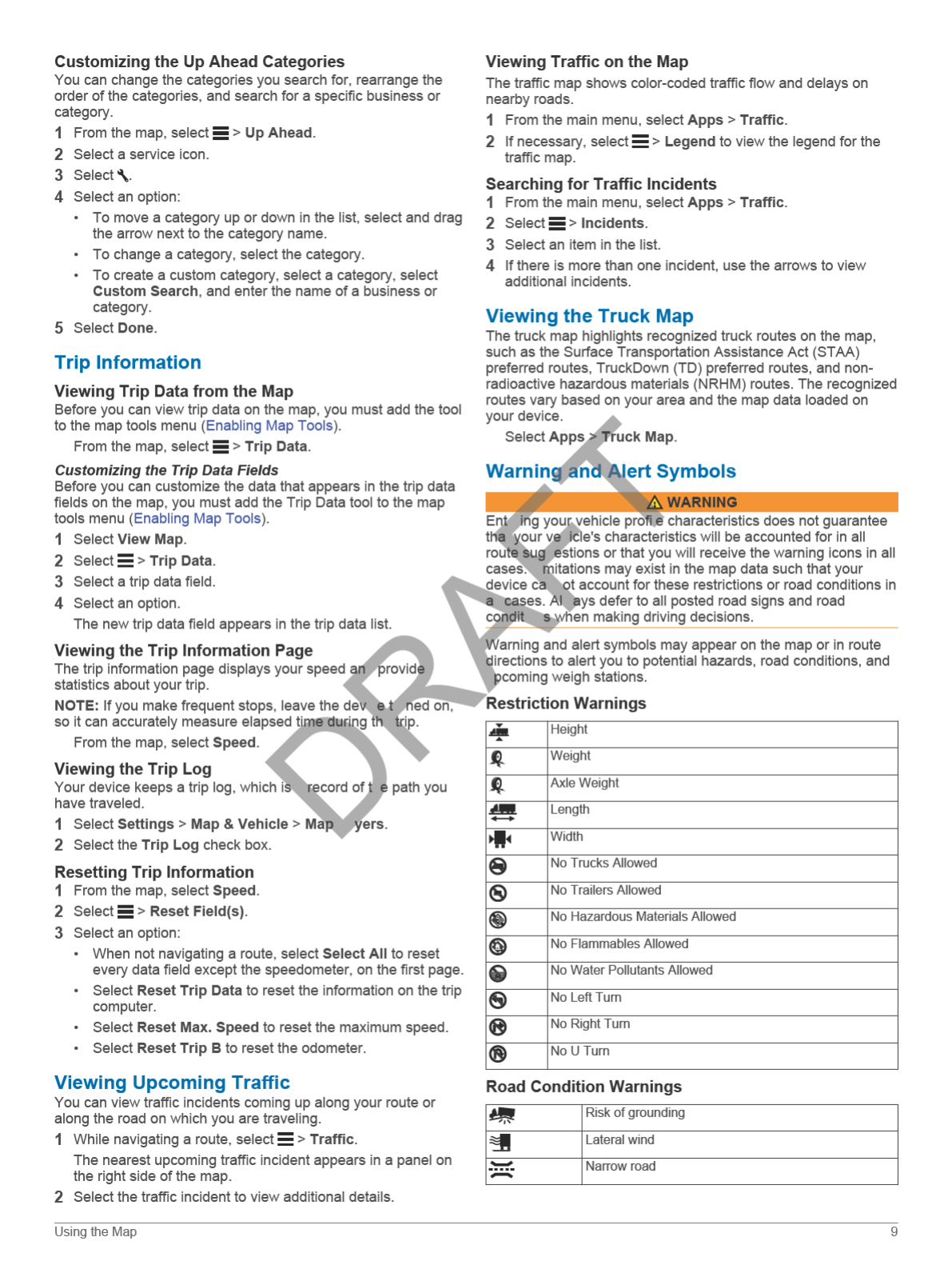
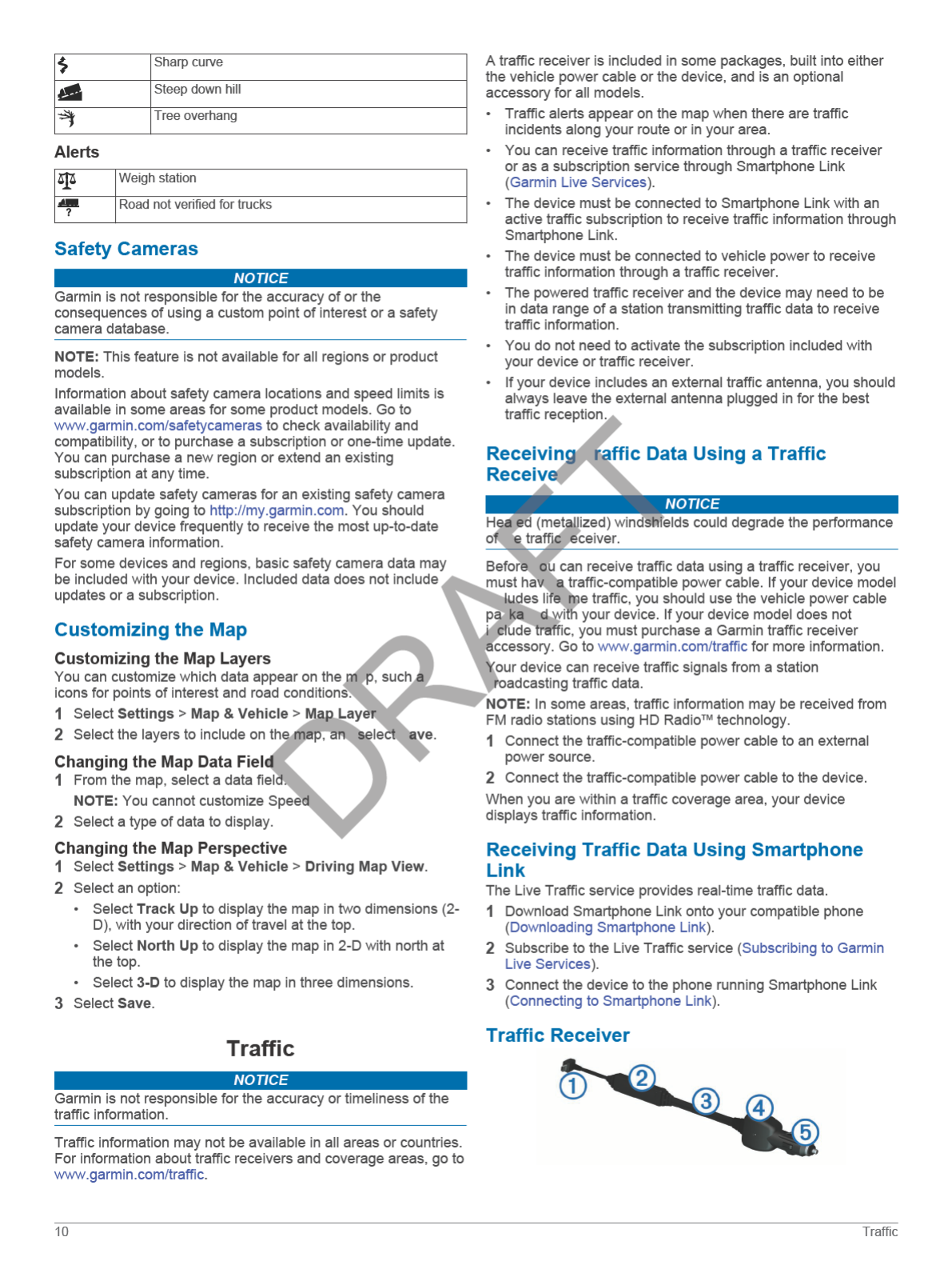
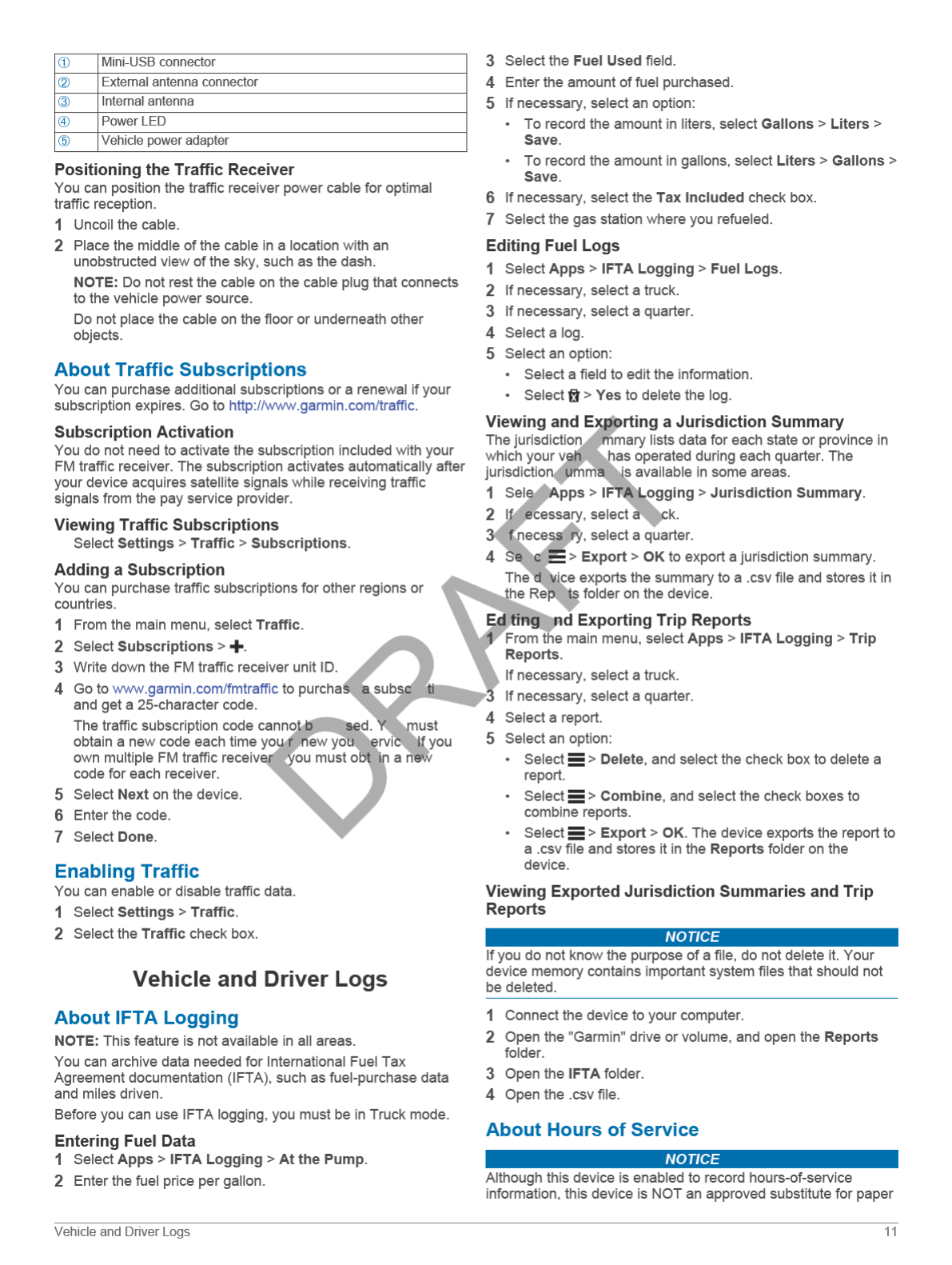

logbook recording requirements under Federal Motor Carrier
Safety Administration regulations. Drivers should comply with all
applicable federal and state paper logbook requirements.
NOTE: This feature is not available in all areas.
Before you can use Hours of Service, you must be in Truck
mode, and you must create a driver profile (Adding Drivers).
You can use Hours of Service to record your working hours,
which may help you comply with safety regulations.
Recording Your Duty Status
1Select Apps > Hours of Service.
2Select a driver.
3Select Duty Status.
4Select an option:
• Select Off Duty to record the time you are off duty.
• Select Sleeper to record the time you are resting in a
sleeper berth.
• Select Driving to record the time you are driving a
commercial motor vehicle in operation.
• Select On Duty to record the time you are on duty, but not
driving a commercial motor vehicle.
• Select Passenger Seat to record the time a second driver
is in the passenger seat but is not on duty.
NOTE: A driver can be in passenger seat status for up to
two hours immediately after or before eight consecutive
hours in the sleeper berth.
5Select Save.
About Drivers
If you work for more than one carrier in a 24-hour period, you
must record each carrier.
You must record the time zone of your home terminal even if
you cross other time zones.
Adding Drivers
1Select Apps > Hours of Service.
2Select .
3Follow the on-screen instructions.
Managing Driver Information
1Select Apps > Hours of Servic
2Select a driver.
3Select Driver Info.
4Select an option:
• To edit the information, select a field.
• To delete the driver, select > Delete Driver > Yes.
Using Driving Logs
1Select Apps > Hours of Service.
2Select a driver.
3Select View Log.
4Select an option:
• To view a different date, select the date at the top of the
screen.
• To view status details, select the field beside a status bar.
• To edit, select the grid, and select a field.
• To view violation information, select .
Adding Shipments
1Select Apps > Hours of Service.
2Select a driver.
3Select Manage Shipments > .
4Enter the reference information, and select Done.
TIP: The reference number is the shipping document
number, or the name of the company and group you are
transporting.
5If necessary, select Start Day.
6If necessary, select End Day.
7Select Save.
Managing Shipments
NOTE: This feature is not available in all areas.
1Select Apps > Hours of Service.
2Select a driver.
3Select Manage Shipments.
4Select a shipment.
5Select an option:
• To edit the shipment information, select a field.
• To delete the shipments, select > Delete Shipments >
OK.
Exporting Driving Logs
1Select Apps > Hours of Service.
2Select a driver
3Select Exp Log.
4If neces ary, en r your tractor number, tractor VIN, and
trailer number.
5If n cessary, select a g to export.
6 necessa y, select the location to which the log should be
e porte .
The de ce exports the log to a .csv file and stores it in the
Reports f der in the device memory.
Vie ing Exported Driving Logs
NOTICE
If you do not know the purpose of a file, do not delete it. Your
device memory contains important system files that should not
e deleted.
1Connect the device to your computer (Connecting the Device
to Your Computer).
2Select an option:
• To view the logs on your device, open the "Garmin" drive
or volume, and open the Reports folder.
• To view the logs on your memory card, open the drive or
volume for the memory card, and open the Garmin folder.
3Open the HOSexports folder.
4Open the .csv file.
Logging Service History
You can log the date and odometer reading when service or
maintenance is performed on your vehicle. The device provides
several service categories, and you can add custom categories
(Adding Service Categories).
1Select Apps > Service History.
2Select a service category.
3Select Add Record.
4Enter the odometer reading, and select Next.
5Enter a comment (optional).
6Select Done.
Adding Service Categories
1Select Apps > Service History.
2Select > Add Category.
3Enter a category name, and select Done.
12 Vehicle and Driver Logs
DRAFT

Deleting Service Categories
When you delete a service category, all service records in the
category are also deleted.
1Select Apps > Service History.
2Select > Delete Categories.
3Select the service categories to delete.
4Select Delete.
Renaming Service Categories
1Select Apps > Service History.
2Select the category to be renamed.
3Select > Rename Category.
4Enter a name, and select Done.
Deleting Service Records
1Select Apps > Service History.
2Select a service category.
3Select > Delete Records.
4Select the service records to be deleted.
5Select Delete.
Editing a Service Record
You can edit the comment, odometer reading, and date of a
service record.
1Select Apps > Service History.
2Select a category.
3Select a field.
4Enter the new information, and select Done.
Hands-Free Features
You can connect your device to a wireless headset and listen to
navigation voice prompts through the headset. Whi e con cted
to a headset, you can connect to a mobile phone to make nd
receive calls using the device and your headse
Enabling Bluetooth Wireless Techno ogy
1Select Settings > Bluetooth.
2Select Bluetooth.
Pairing Your Phone
1Place your phone and your dēzl device within 33 ft. (10 m) of
each other.
2On your phone, enable Bluetooth wireless technology, and
set the phone to be discoverable.
3On your dēzl device, select Settings > Bluetooth.
4Follow the on-screen instructions on your phone and your
dēzl device.
Tips After Pairing the Devices
• After the initial pairing, the two devices can connect
automatically e ch time you turn them on.
• When your one is connected to your device, you are ready
to receiv voic calls.
• When you turn on e device, it tries to connect to the last
pho e to which it wa connected.
• ou might need to set your phone to connect to the device
utomat ally when the device is turned on.
Placin a Call
Dialing a N mber
1lect Apps > Phone > Dial.
2Enter the number.
3Select Dial.
Calling a Contact in Your Phone Book
Your phone book is loaded from your phone to the device each
time your phone and the device connect. It may take a few
minutes for the phone book to be available. Some phones do
not support this feature.
1Select Apps > Phone > Phone Book.
2Select a contact.
3Select Call.
Calling a Location
1Select Apps > Phone > Browse Categories.
2Select a point of interest.
3Select Call.
Receiving a Call
When you receive a call, select Answer or Ignore.
Using the Call History
Your call history is loaded from your phone to the device each
time your phone and the device connect. It may take a few
minutes for the call history to be available. Some phones do not
support this feature.
1Select Apps > Phone > Call History.
2Select a category.
A list of calls appears, with the most recent calls at the top.
3Select a call.
Using In-Call Options
While on a call, you can select in-call options from the map.
• To transfer audio to your phone, select .
Hands-Free Features 13
RAFT

TIP: You can use this feature if you want to turn off your
device and remain on the call, or if you need privacy.
• To use the dial pad, select .
TIP: You can use this feature to use automated systems,
such as voice mail.
• To mute the microphone, select .
• To hang up, select .
Saving a Home Phone Number
TIP: After you save a home number, you can edit the home
number by editing “Home” in your list of saved locations (Editing
a Saved Location).
1Select Apps > Phone > > Set Home Number.
2Enter your phone number.
3Select Done.
Calling Home
Before you can call home, you must enter a phone number for
your home location.
Select Apps > Phone > Call Home.
Pairing Additional Bluetooth Devices
1Place your headset or phone and your Bluetooth device
within 33 ft. (10 m) of each other.
2On your device, enable Bluetooth wireless technology.
3On your headset or phone, enable Bluetooth wireless
technology and make it visible to other Bluetooth devices.
4On your device, select Settings > Bluetooth > Search for
Devices.
A list of nearby Bluetooth devices appears.
5Select your headset or phone from the list.
6Select OK.
Disconnecting a Bluetooth Device
You can temporarily disconnect a Bluetooth de ce withou
deleting it from the paired devices list. The Blue oth d ice
still connect to your dēzl device automatically in th f ture.
1Select Settings > Bluetooth.
2Select the device you want to di onnect.
3Clear the device check box.
Deleting a Paired Bluetooth Device
You can delete a paired Bluetooth device to p event it from
automatically connecting to your dēzl device in the future.
1Select Settings > Bluetooth.
2Select the device to delete.
3Select Unpair device.
Using the Apps
Using Help
Select Apps > Help to view information about using the
device.
Searching Help Topics
Select Apps > Help > .
Smartphone Link
Smartphone Link is a phone application that allows you to
synchronize location data with your phone and access live
information using your phone data connection. Your device
transfers data from Smartphone Link using Bluetooth wireless
technology. Live information is available through free and
subscription-based plans from Garmin Live Services (Garmin
Live Services).
Saved locations and recently found locations are synchronized
with your phone each time your device connects to Smartphone
Link.
Downloading Smartphone Link
Smartphone Link is available for some smartphones. Go to
www.garmin.com/smartphonelink or see the application store for
your phone for compatibility and availability information.
Download Smartphone Link from the application store on
your supported phone.
See your phone owner's manual for information on
downloading and installing applications.
Connecting to Smartphone Link
Before you can connect to Smartphone Link, you must
download and install the Smartphone Link application on your
phone.
1Start Smartphone Link on your phone.
2From your device, select Settings > Bluetooth.
3Select the Bluet oth check box.
4From your ph ne, enable Bluetooth wireless technology, and
scan for n arb Bluetooth devices.
See your phone ner's manual for more information.
5Fro your phone, se ct your device from the list of nearby
d vices.
6Follow the on-screen instructions on your phone and on your
de ic to confirm the pairing request.
app ars in the status bar on your device when
Smartph ne Link is connected.
Sendi a Location from Your Phone to Your Device
Smartphone Link is registered as a navigation application on
your phone.
From your phone, select the button to start navigating to a
location (see the owner's manual for your phone).
2From the application menu, select Smartphone Link.
The next time you connect your device to your phone, the
location is transferred to the recently found items on your
device.
Disabling Calls While Connected to Smartphone Link
While the device is connected to the phone and receiving
Garmin Live Services, you can disable hands-free calling.
1Select Settings > Bluetooth.
2Select your phone.
3Clear the Phone calls check box.
Garmin Live Services
Before you can use Garmin Live Services, your device must be
connected to a supported phone running Smartphone Link
(Connecting to Smartphone Link).
Connecting to Smartphone Link provides access to Garmin Live
Services. Garmin Live Services provides free and subscription-
based plans to view live data on your device, such as traffic
conditions and weather.
Some services, like weather, are available as separate apps on
your device. Other services, like traffic, enhance the existing
navigation features on your device. Features that require access
to Garmin Live Services display the Smartphone Link symbol
and appear only when the device is connected to Smartphone
Link.
14 Using the Apps
DRAFT

Subscribing to Garmin Live Services
Before you can subscribe to Garmin Live Services, you must
install the Smartphone Link app on your phone.
1Start the Smartphone Link app on your phone (Connecting to
Smartphone Link).
2Select My Account.
A list of services and subscription prices appears.
3Select a service.
4Select the price.
5Select Subscribe.
6Follow the on-screen instructions.
About Traffic Cameras
Traffic cameras provide live images of traffic conditions on major
roadways and intersections. You can save cameras that you
want to view regularly.
Saving a Traffic Camera
Before you can use this feature, you must subscribe to the
photoLive service, and your device must be connected to a
supported phone running Smartphone Link (Smartphone Link).
This feature is not available in all areas.
1Select Apps > photoLive.
2Select Touch to Add.
3Select a road.
4Select an intersection.
5Select Save.
Viewing a Traffic Camera
Before you can view a traffic camera, you must save a traffic
camera (Saving a Traffic Camera).
1Select Apps > photoLive.
2Select a camera.
About ecoRoute
In some areas, before you can use ecoRoute™ eatures ou
must purchase an unlock code or an ecoRoute H ac essory.
Go to www.garmin.com/ecoroute for more informati
NOTE: The ecoRoute feature is avail ble only en th device
is set to use automobile transportat n mode.
The ecoRoute feature calculates the uel economy nd the fuel
price of navigating to a destination, and ffers tool for
improving fuel efficiency.
The data provided by the ecoRoute feature is an estimate only.
The data is not actually read from the vehicle, unless you are
using the ecoRoute HD accessory.
To receive more-accurate fuel reports for your specific vehicle
and driving habits, calibrate the fuel economy (Calibrating the
Fuel Economy).
ecoRoute HD Accessory
When connected to the ecoRoute HD accessory, your device
can receive real-time vehicle information, such as error
messages, RPM, and battery voltage. Your device includes data
read from the vehicle by the ecoRoute HD accessory when
calculating ecoRoute data.
The ecoRoute HD accessory is compatible only with devices
that have Bluetooth wireless technology.
Go to www.garmin.com/ecoRoute.
Setting Up the Vehicle
The first time you use the ecoRoute features, you must enter
vehicle information.
1Select Apps > ecoRoute.
2Follow the on-screen instructions.
Changing the Fuel Price
1Select Apps > ecoRoute > At the Pump.
2Enter the current price of fuel, and select Next.
3Select Yes.
Calibrating the Fuel Economy
You can calibrate the fuel economy to receive more-accurate
fuel reports for your specific vehicle and driving habits. You
should calibrate when you fill up your fuel tank.
1Select Apps > ecoRoute > At the Pump.
2Enter the current fuel price.
3Enter the amount of fuel the vehicle has used since the last
time the fuel tank was filled.
4Enter the distance you have traveled since the last time the
fuel tank was filled.
5Select Next.
The device calculates the average vehicle fuel economy.
6Select Save.
About ecoChallenge
ecoChallenge help you maximize the vehicle fuel economy by
scoring your drivi g habits. The higher your ecoChallenge
scores, the m fuel you have saved. The ecoChallenge
collects dat and c lculates a score whenever your device is
moving and in Autom bile transportation mode.
Viewi g ecoChallenge cores
elect Ap s > ecoRoute > ecoChallenge.
Abo t th ecoChallenge Score
Accele tion: Displays your score for smooth and gradual
accele tion. You lose points for rapid acceleration.
B king: Dis lays your score for smooth and gradual braking.
You e points for hard braking.
Overall: Displays an average of the speed, acceleration, and
braking score.
peed: Displays your score for driving your vehicle at the
optimal speed for conserving fuel.
Resetting the ecoChallenge Scores
1Select Apps > ecoRoute > ecoChallenge.
2Select > Reset.
Viewing Fuel Economy Information
1Select Apps > ecoRoute > Fuel Economy.
2Select a section of the graph to zoom in.
Mileage Reports
Mileage reports provide the distance, the time, the average fuel
economy, and the fuel cost of navigating to a destination.
A mileage report is created for every route that you drive. If you
stop a route on your device, a mileage report is created for the
distance you traveled.
Viewing a Mileage Report
You can view saved mileage reports on the device.
TIP: You can connect the device to your computer and access
mileage reports in the Reports folder on the device.
1Select Apps > ecoRoute > Mileage Report.
2Select a report.
Resetting ecoRoute Information
1Select Apps > ecoRoute > Vehicle Profile.
2Select Reset.
Driving Tips
• Drive the speed limit. In most vehicles, you will achieve
optimal fuel economy between 45 mph and 60 mph.
Using the Apps 15
DRAFT

• Drive a consistent speed.
• Brake and accelerate gradually and consistently.
• Avoid stop-and-go traffic and rush hour.
• Do not rest your foot on the brake pedal.
• Use the cruise control.
• Turn your vehicle off instead of idling for temporary stops.
• Combine small trips into one longer trip with multiple stops.
• Turn off the air conditioner and open your windows, unless
you are traveling at high speeds on the highway.
• Tighten your gas cap.
• Park in the shade or in the garage.
• Unload excess weight. Remove unneeded items from your
vehicle.
• Avoid carrying items on your roof. Remove rooftop carriers
and removable racks when not in use.
• Maintain the recommended tire pressure. Check tire pressure
regularly and before long trips.
• Keep your vehicle well-tuned, and follow the vehicle
manufacturer’s recommended maintenance intervals.
• Change your oil, oil filters, and air filters regularly.
• Use the lowest recommended suitable grade of fuel. Use
biofuels when feasible, such as E85 and biodiesel.
Viewing myGarmin Messages
Before you can use this feature, your device must be connected
to a supported phone running Smartphone Link (Connecting to
Smartphone Link). This feature is not available in all areas.
You can view messages from myGarmin, such as notifications
for software and map updates.
1Select Apps > myGarmin.
If you have unread messages, the number of unread
messages appears on the myGarmin icon.
2Select a message subject.
The full message appears.
Viewing the Weather Foreca
Before you can use this feature, you device mu be co ected
to a supported phone running Sma phone Link (C nnecting to
Smartphone Link). This feature is no vailable in a areas.
1Select Apps > Weather.
2Select a day.
The detailed forecast for that day appears.
Viewing Weather Near a Different City
1Select Apps > Weather > Current Location.
2Select an option:
• To view weather for a favorite city, select a city in the list.
• To add a favorite city, select Add City, and enter a city
name.
Viewing the Weather Radar
Before you can use this feature, you must purchase Advanced
Weather service using Smartphone Link.
You can view an animated, color-coded radar map of current
weather conditions, as well as a weather icon on the map. The
weather icon changes to show weather in the vicinity, such as
rain, snow, and thunderstorms.
1Select Apps > Weather.
2If necessary, select a city.
3Select > Weather Radar.
Viewing Weather Alerts
Before you can use this feature, you must purchase Advanced
Weather service using Smartphone Link.
While you are traveling with your device, weather alerts may
appear on the map. You can also view a map of weather alerts
near your current location or near a selected city.
1Select Apps > Weather.
2If necessary, select a city.
3Select > Weather Alerts.
Checking Road Conditions
Before you can use this feature, you must purchase Advanced
Weather service using Smartphone Link.
1Select Apps > Weather.
2If necessary, select a city.
3Select > Road Conditions.
Viewing Previous Routes and Destinations
Before you can use this feature, you must enable the travel
history feature (Device and Privacy Settings).
You can view your revious routes and places you have stopped
on the map.
Select Ap s > Where I've Been.
Customizing the Device
Map and Vehicle Settings
Select ttings > Map & Vehicle.
Vehicle: S s the icon that represents your position on the map.
Go to www.garmingarage.com for more icons.
D iving Map View: Sets the perspective on the map.
Map Detail: Sets the level of detail on the map. More detail may
cause the map to draw slower.
Map Theme: Changes the color of the map data.
Map Tools: Sets the shortcuts that appear in the map tools
menu.
Map Layers: Sets the data that appears on the map page
(Customizing the Map Layers).
myMaps: Sets which installed maps the device uses.
Enabling Maps
You can enable map products installed on your device.
TIP: To purchase additional map products, go to
http://buy.garmin.com.
1Select Settings > Map & Vehicle > myMaps.
2Select a map.
Navigation Settings
To open the Navigation settings page, from the main menu,
select Settings > Navigation.
Calculation Mode: Sets the route calculation method.
Avoidances: Sets road features to avoid on a route.
Custom Avoidances: Allows you to avoid specific roads or
areas.
Environmental Zones: Sets the avoidance preferences for
areas with environmental or emissions restrictions that may
apply to your vehicle.
Toll Roads: Sets preferences for avoiding toll roads.
Tolls and Fees: Sets preferences for avoiding toll roads and toll
stickers.
NOTE: This feature is not available in all areas.
16 Customizing the Device
DRAFT

Restricted Mode: Disables all functions that require significant
operator attention and could become a distraction while
driving.
GPS Simulator: Stops the device from receiving a GPS signal,
and saves battery power.
Calculation Mode Settings
Select Settings > Navigation > Calculation Mode.
The route calculation is based on road speeds and vehicle
acceleration data for a given route.
Faster Time: Calculates routes that are faster to drive but can
be longer in distance.
Shorter Distance: Calculates routes that are shorter in distance
but can take more time to drive.
Less Fuel: Calculates routes that could use less fuel than other
routes.
Off Road: Calculates a direct line from your location to your
destination.
Setting a Simulated Location
If you are indoors or not receiving satellite signals, you can use
the GPS to set a simulated location.
1Select Settings > Navigation > GPS Simulator.
2From the main menu, select View Map.
3Tap the map twice to select an area.
The address of the location appears at the bottom of the
screen.
4Select the location description.
5Select Set Location.
Bluetooth Settings
Select Settings > Bluetooth.
Bluetooth: Enables Bluetooth wireless technology.
Search for Devices: Searches for nearby Bluetoo h devic s.
Friendly Name: Allows you to enter a friendly name that
identifies your device on other devices with B etooth
wireless technology.
Disabling Bluetooth
1Select Settings > Bluetooth.
2Select Bluetooth.
Display Settings
To open the Display settings page, from the main menu, select
Settings > Display.
Color Mode: Sets the device to display day or night colors. You
can select Auto to allow the device to automatically set day or
night colors based on the time of day.
Brightness: Adjusts the display brightness.
Display Timeout: Sets the amount of idle time before your
device enters sleep mode.
Screenshot: Allows you to take a picture of the device screen.
Screenshots are saved in the Screenshot folder of the device
storage.
Traffic Settings
To open the traffic settings page, from the main menu, select
Settings > Traffic.
Traffic: Enables traffic.
Current Provider: Sets the traffic provider to use for traffic data.
Auto selects the best available traffic data automatically.
Subscriptions: Lists current traffic subscriptions.
Optimize Route: Selects whether to use optimized alternate
routes automatically or upon request (Avoiding Traffic Delays
on Your Route).
Traffic Alerts: Selects the traffic delay severity for which the
device displays a traffic alert.
Units and Time Settings
To open the Units and Time settings page, from the main menu,
select Settings > Units & Time.
Current Time: Sets the device time.
Time Format: Allows you to select a 12-hour, 24-hour, or UTC
display time.
Units: Sets the unit of measure used for distances.
Position Format: Sets the coordinate format and datum used
for geographical coordinates.
Setting the Time
1From the main menu, select the time.
2Select an option:
• To set the time automatically using GPS information,
select Automatic.
• To set the me manually, drag the numbers up or down.
Language and Keyboard Settings
To open he Languag and Keyboard settings, from the main
menu select Settings > anguage & Keyboard.
Vo ce Language: Sets the language for voice prompts.
Text an uage: Sets all on-screen text to the selected
lang age.
NOTE: Changing the text language does not change the
nguage f user-entered data or map data, such as street
nam
Keyboard Language: Enables keyboard languages.
Proximity Alerts Settings
NOTE: You must have custom points of interest (POIs) loaded
for proximity points alerts to display.
Select Settings > Proximity Alerts.
Audio: Sets the style of alert that plays when you approach
proximity points.
Alerts: Sets the type of proximity points for which alerts are
played.
Device and Privacy Settings
To open the device settings, select Settings > Device.
About: Displays the software version number, the unit ID
number, and information on several other software features.
EULAs: Displays the end-user license agreements.
NOTE: You need this information when you update the
system software or purchase additional map data.
Position Reporting: Shares your position information with
Garmin to improve content.
Travel History: Allows the device to record information for the
myTrends, Where I’ve Been, and Trip Log features.
Clear Travel History: Clears your travel history for the
myTrends, Where I’ve Been, and Trip Log features.
Restoring Settings
You can restore a category of settings or all settings to the
factory default values.
1Select Settings.
2If necessary, select a settings category.
Customizing the Device 17
DRAFT
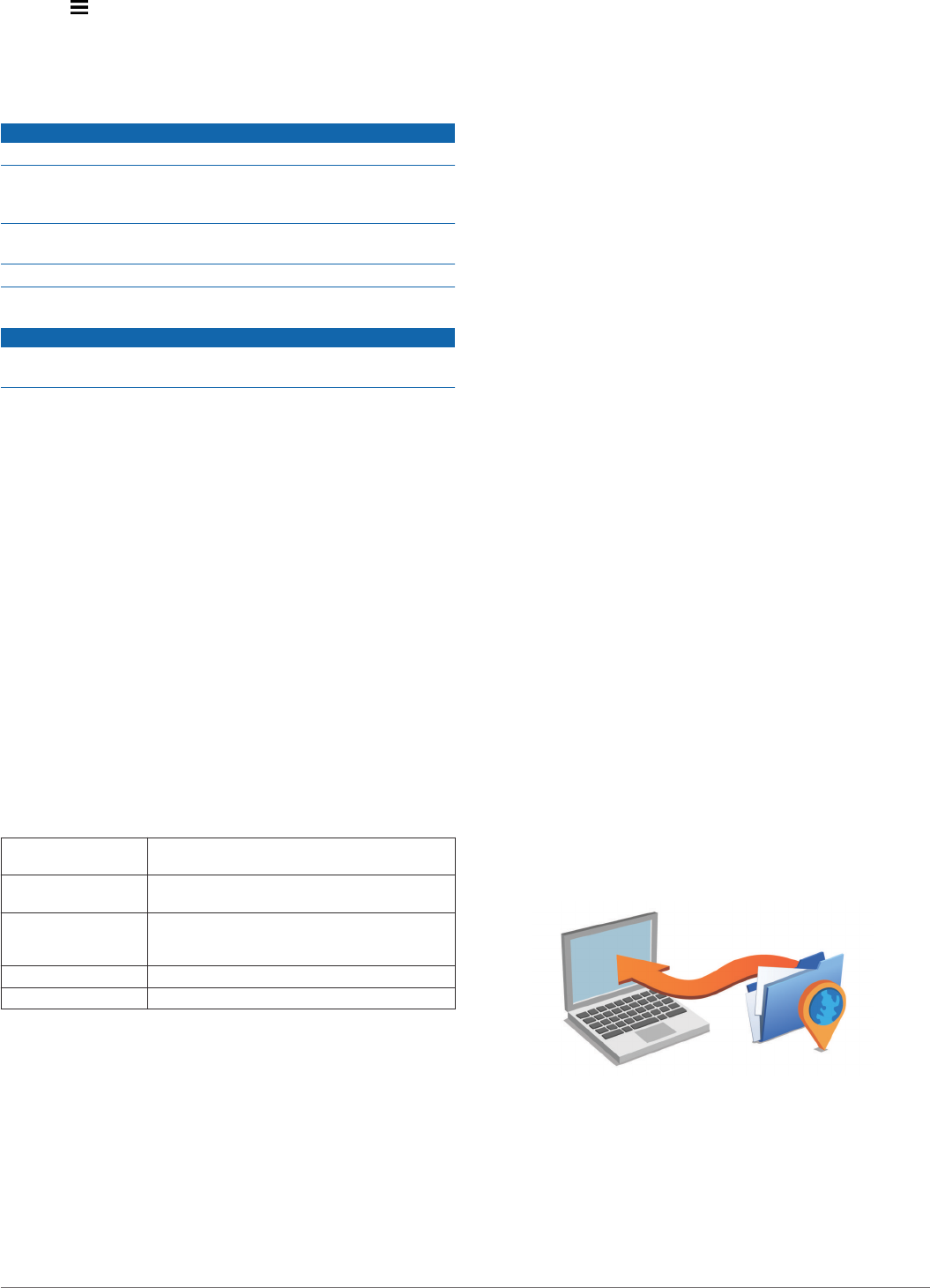
3Select > Restore.
Device Information
Device Care
NOTICE
Avoid dropping your device.
Do not store the device where prolonged exposure to extreme
temperatures can occur, because it can cause permanent
damage.
Never use a hard or sharp object to operate the touchscreen, or
damage may result.
Do not expose the device to water.
Cleaning the Outer Casing
NOTICE
Avoid chemical cleaners and solvents that can damage plastic
components.
1Clean the outer casing of the device (not the touchscreen)
using a cloth dampened with a mild detergent solution.
2Wipe the device dry.
Cleaning the Touchscreen
1Use a soft, clean, lint-free cloth.
2If necessary, lightly dampen the cloth with water.
3If using a dampened cloth, turn off the device and disconnect
the device from power.
4Gently wipe the screen with the cloth.
Avoiding Theft
• Remove the device and mount from sight when not in use.
• Remove the residue left on the windshield by the suct n cup.
• Do not keep your unit in the glove compartment.
• Register your device at http://my.garmin.com
Resetting the Device
You can reset your device if it stops nctioning.
Hold the power key for 12 secon s.
Specifications
Operating
temperature range
-4° to 131°F (-20° to 55 C
Charging temperature
range
32° to 113°F (0° to 45°C)
Power input Vehicle power using the included vehicle power
cable. AC power using an optional accessory
(for home and office use only).
Battery life Up to 1 hr. depending on usage and settings
Battery type Rechargeable Lithium-ion
Appendix
Support and Updates
Garmin Express™ provides easy access to these services for
Garmin devices. Some services may not be available for your
device.
• Product registration
• Product manuals
• Software updates
• Map, chart, or course updates
• Vehicles, voices, and other extras
Setting Up Garmin Express
1Connect the device to your computer using a USB cable.
2Go to www.garmin.com/express.
3Follow the on-screen instructions.
nüMaps Guarantee™
Your device may be eligible for a free map update within 90
days of first acquiring satellites while driving. Go to
www.garmin.com/numaps for terms and conditions.
Lifetime Subscriptions
Some models include subscriptions to lifetime features. For
more information, go to www.garmin.com/lmt.
LT: This model includes a lifetime traffic subscription and a
traffic receiver.
LM: This model includes a nüMaps Lifetime™ subscription,
which provides quarterly map updates for the useful life of
your device. For terms and conditions go to www.garmin.com
/us/maps/numaps_lifetime.
LMT: This model includes a nüMaps Lifetime subscription,
lifetime traffic subscription, and a traffic receiver.
LMTHD or LMT-D: This model includes a nüMaps Lifetime
subscription l etime digital traffic subscription, and a digital
traffic recei
Activating Lifetime Maps
NOTE: Lifetime Maps a e not applicable to products that do not
have pre-loaded maps.
N TE: Lifet me Maps entitle you to receive map updates when
and a su h updates are made available by Garmin during the
useful l of one compatible Garmin product or as long as
Garmin re eives map data from a third party supplier, whichever
i horter. F the meaning of a product’s “useful life” and for
oth r ortant terms and conditions, go to www.garmin.com
umapslifetime.
1Go to www.garmin.com/express.
Follow the on-screen instructions.
NOTE: If you register the device, you can receive e-mail
notifications when a map update is available.
Updating Maps and Software with Garmin Express
You can use Garmin Express software to download and install
the latest map and software updates for your device. Map
updates provide the latest available mapping data to ensure
your device continues to calculate accurate and efficient routes
to your destinations. Garmin Express is available for Windows®
and Mac® computers.
1On your computer, go to www.garmin.com/express.
2Select an option:
• To install on a Windows computer, select Download for
Windows.
• To install on a Mac computer, select Mac Version.
3Open the downloaded file, and follow the on-screen
instructions to complete the installation.
4Start Garmin Express.
5Connect your Garmin device to your computer using a USB
cable.
18 Device Information
DRAFT
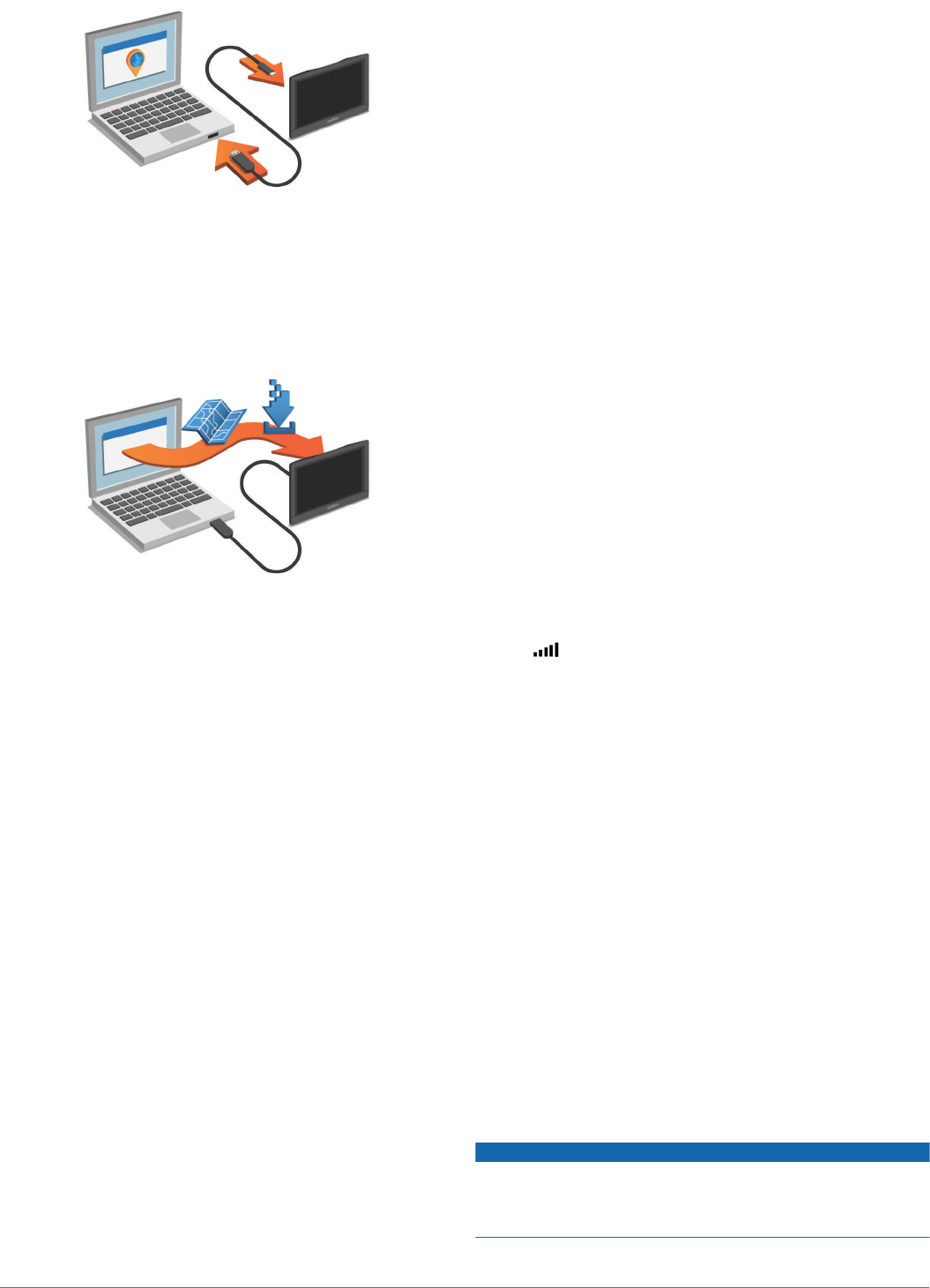
The Garmin Express software detects your device.
6Enter an email address for product registration (optional).
7Click save device.
8Click check for updates.
A list of available map and software updates appears.
9Select the updates to install.
10Click Install Now.
The Garmin Express software downloads and installs the
updates onto your device. Map updates are very large, and this
process may take a long time on slower Internet connections.
Data Management
You can store files on your device. The device as a me ory
card slot for additional data storage.
NOTE: The device is not compatible with Wi dows 98, Me,
Windows NT®, and Mac OS 10.3 and earlier.
File Types
The device supports these file types.
• Maps and GPX waypoint files from myGarmin mapping
software, including MapSource®, BaseC m ™, and
HomePort™ (Custom Points of Interest).
• GPI custom POI files from Garmin POI Loader (Installing POI
Loader).
About Memory Cards
You can purchase memory cards from an electronics supplier,
or purchase pre-loaded Garmin mapping software
(www.garmin.com). In addition to map and data storage, the
memory card can be used to store files such as maps, images,
geocaches, routes, waypoints, and custom POIs.
Installing a Memory Card
The device supports microSD™ and microSDHC memory cards.
1Insert a memory card into the slot on the device.
2Press it in until it clicks.
Connecting the Device to Your Computer
You can connect the device to your computer using a USB
cable.
1Plug the small end of the USB cable into the port on the
device.
2Plug the larger end of the USB cable into a port on your
computer.
A picture of your device connected to a computer appears on
the device screen.
Depending on your computer operating system, the device
appears as either a portable device, a removable drive, or a
removable volume.
Transferring Data From Your Computer
1Connect the device to your computer (Connecting the Device
to Your Computer).
Depending on your computer operating system, the device
appears as either a portable device, a removable drive, or a
removable volume.
2On your computer, open the file browser.
3Select a file.
4Select Edit > Copy.
5Browse to a folder on the device.
NOTE: For a removable drive or volume, you should not
place files in the Garmin folder.
6Select Edit > Paste.
Disconnecting the USB Cable
If your device is co nected to your computer as a removable
drive or volume ou must safely disconnect your device from
your compute to avoid data loss. If your device is connected to
your Windo s com uter as a portable device, it is not necessary
to safely disconnect.
1Complete an action:
For Wi dows computers, select the Safely Remove
Har ware icon in the system tray, and select your device.
• F r Mac computers, drag the volume icon to the trash.
2Disconn ct the cable from your computer.
Viewing GPS Signal Status
Hold for three seconds.
Power Cables
Your device can be powered various ways.
• Vehicle power cable
• USB cable
• AC adapter (optional accessory)
Charging the Device
NOTE: This Class III product shall be powered by an LPS power
supply.
You can charge the battery in the device using any of these
methods.
• Connect the device to the vehicle power cable.
• Connect the device to a computer using a USB cable.
The device may charge slowly when connected to a
computer. Some portable computers may not charge the
device.
• Connect the device to an optional power adapter accessory,
such as a wall power adapter.
You can purchase an approved Garmin AC-DC adapter
suitable for home or office use from a Garmin dealer or
www.garmin.com.
Changing the Fuse in the Vehicle Power Cable
NOTICE
When replacing the fuse, do not lose any of the small pieces
and make sure they are put back in the proper position. The
vehicle power cable does not work unless it is assembled
correctly.
Appendix 19
DRAFT
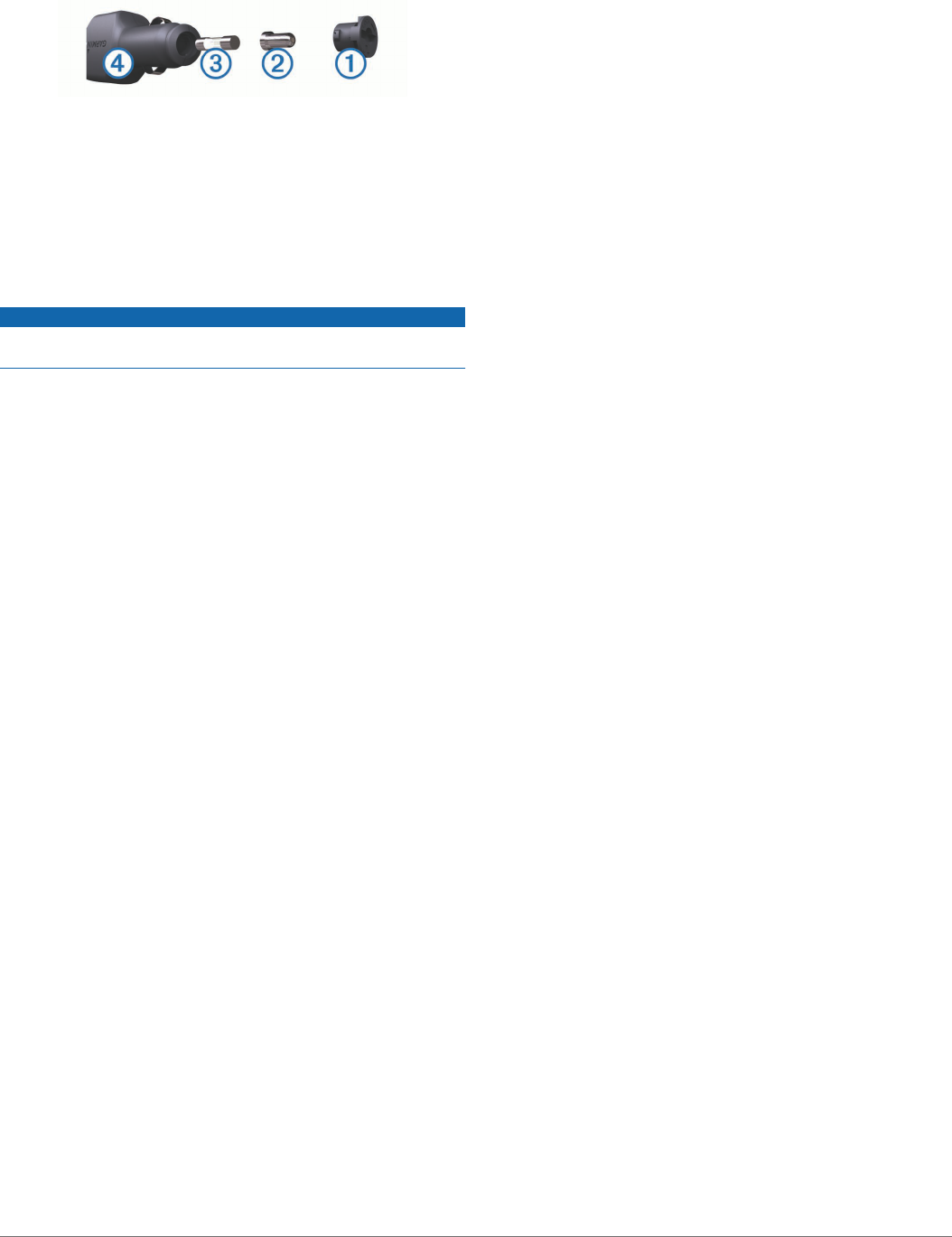
If your device does not charge in your vehicle, you may need to
replace the fuse located at the tip of the vehicle adapter.
1Rotate the end piece À 90 degrees counter clockwise to
unlock it.
TIP: You may need to use a coin to remove the end piece.
2Remove the end piece, the silver tip Á, and the fuse Â.
3Insert a new fast-blow fuse that has the same current, such
as 1 A or 2 A.
4Place the silver tip in the end piece.
5Push in the end piece and rotate it 90 degrees clockwise to
lock it back into the vehicle power cable Ã.
Mounting on Your Dashboard
NOTICE
The permanent mounting adhesive is extremely difficult to
remove after it is installed.
You can use an optional mounting disk to mount your device to
the dashboard and comply with certain state regulations. See
www.garmin.com for more information.
1Clean and dry the dashboard where you are placing the disk.
2Remove the backing from the adhesive on the bottom of the
disk.
3Place the disk on the dashboard.
4Remove the clear plastic cover from the top of the disk.
5Place the suction cup mount on top of the disk.
6Flip the lever down (toward the disk).
Removing the Device, Mount, an Suction
Cup
Removing the Device from the M unt
1Press the release button on the b ttom of the evice
2Tilt the device forward.
Removing the Mount from the Su ion Cu
1Turn the device mount to the right or le
2Apply pressure until the socket on the mount releases the
ball on the suction cup.
Removing the Suction Cup from the Windshield
1Flip the lever on the suction cup toward you.
2Pull the tab on the suction cup toward you.
Purchasing Additional Maps
1Go to your device product page at (www.garmin.com).
2Click the Maps tab.
3Follow the on-screen instructions.
Purchasing Accessories
Go to http://buy.garmin.com.
Troubleshooting
The suction cup will not stay on my
windshield
1Clean the suction cup and windshield with rubbing alcohol.
2Dry with a clean, dry cloth.
3Mount the suction cup (Connecting the Device to Vehicle
Power).
My device is not acquiring satellite signals
• Verify the GPS simulator is turned off (Navigation Settings).
• Take your device out of parking garages and away from tall
buildings and trees.
• Remain stationary for several minutes.
The device does not charge in my vehicle
• Check the fuse in the vehicle power cable (Changing the
Fuse in the Vehicle Power Cable).
• Verify the vehicle is turned on and is supplying power to the
power outlet.
• Verify the interior temperature of the vehicle is in the
following temperature range: from 0° to 45°C (from 32° to
113°F).
• Verify the fuse is not broken in the vehicle power outlet.
My battery does not stay charged for very
long
• Decrease he s reen brightness (Display Settings).
• Shorten the displa timeout (Display Settings).
• De ease the volume Adjusting the Volume).
• Disable Bl etooth wireless technology (Disabling Bluetooth).
• P t the device in sleep mode when not in use (Entering and
Exit g Sleep Mode).
• Keep y ur device away from extreme temperatures.
• not leave your device in direct sunlight.
My device does not appear as a removable
drive on my computer
n most Windows computers, the device connects using Media
Transfer Protocol (MTP). In MTP mode, the device appears as a
portable device and not as a removable drive. MTP mode is
supported by Windows 7, Windows Vista®, and Windows XP
Service Pack 3 with Windows Media Player 10.
My device does not appear as a portable
device on my computer
On Mac computers and some Windows computers, the device
connects using USB mass storage mode. In USB mass storage
mode, the device appears as a removable drive or volume, and
not as a portable device. Windows versions prior to Windows XP
Service Pack 3 use USB mass storage mode.
My device does not appear as either a
portable device or a removable drive or
volume on my computer
1Disconnect the USB cable from your computer.
2Turn off the device.
3Plug the USB cable into a USB port on your computer and
into your device.
TIP: Your device should be connected directly to a USB port
on your computer and not to a USB hub.
The device automatically turns on and goes into MTP mode or
USB mass storage mode. A picture of the device connected to a
computer appears on the device screen.
My phone will not connect to the device
• Select Settings > Bluetooth.
20 Troubleshooting
DRAFT

The Bluetooth field must be set to Enabled.
• Enable Bluetooth wireless technology on your phone and
bring your phone within 33 ft. (10 m) of the device.
• Go to www.garmin.com/bluetooth for more help.
Troubleshooting 21
DRAFT


